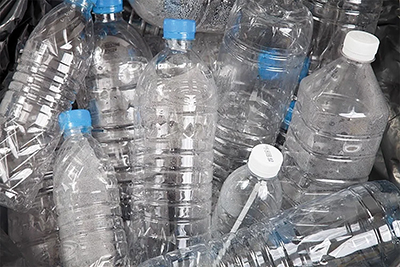
By Vicki Contie
NIH Research Matters
Researchers developed an imaging technique that detected thousands of tiny bits of plastic in common single-use bottles of water.
The technique can help to shed light on the presence and impact of extremely small particles called nanoplastics, which are widespread but poorly understood.
Scientists found that tiny plastic particles can enter nerve cells, impair breakdown of structures linked to Parkinson’s disease, and harm certain brain regions in mice.
The findings point to molecular links between plastics and Parkinson’s disease mechanisms that can be further explored through additional research.
Plastics are a part of our everyday lives, and plastic pollution is a growing concern. When plastics break down over time, they can form smaller particles called microplastics, which are 5 mm or less in length—smaller than a sesame seed. Microplastics, in turn, can break down into even smaller pieces called nanoplastics, which are less than 1 μm in size. Unable to be seen with the naked eye, these are small enough to enter the body’s cells and tissues.
Previous research has found evidence of plastic particles in human blood, lungs, gut, feces, and reproductive tissues like the placenta and testes. But, the potential health effects of these tiny plastic bits are still unproven and unknown. The small size of nanoparticles has made them especially difficult to detect and study.
To gain more insight into nanoplastics, a research team led by Drs. Wei Min and Beizhan Yan of Columbia University modified a powerful imaging technique that Min co-invented 15 years ago with NIH support.
To test their new high-throughput imaging platform, the team analyzed the micro- and nanoplastics in three popular brands of bottled water. Results were reported on January 8, 2024, in the Proceedings of the National Academy of Sciences.
The researchers found that, on average, a liter of bottled water included about 240,000 tiny pieces of plastic. About 90% of these plastic fragments were nanoplastics. This total was 10 to 100 times more plastic particles than seen in earlier studies, which mostly focused on larger microplastics.
The water contained particles of all seven types of plastic. The most common was polyamide, a type of nylon that’s often used to help filter and purify water. An abundance of polyethylene terephthalate (PET) was also detected. This might be expected, since PET is used to make bottles for water, soda, and many other drinks and foods.
The researchers say that this new technique will help to advance our understanding of human exposure to nanoplastics. “This opens a window where we can look into a plastic world that was not exposed to us before,” Yan says.
In the future, the researchers will apply this approach to analyze more environmental samples, such as tap water, indoor and outdoor air samples, and biological tissues.
Parkinson’s disease and related dementias have been on the rise worldwide. These disorders are marked by an abnormal buildup of the protein alpha-synuclein in the brain. Research points to a potential role for environmental factors.
Small bits of plastic are widely found throughout the environment, including food and water supplies. Microplastics are plastic particles smaller than 5 mm in diameter—tinier than a sesame seed; nanoplastics are less than 1 μm, too small to be seen by the human eye. At least one previous study found that particles of polystyrene and other plastics can be detected in the blood of most healthy adults. Single-use polystyrene products—like plastic cups, utensils, and foam packing—are widespread environmental waste. But despite their ubiquity, the potential health consequences of these plastics are only beginning to be studied and understood.
An international research team led by Dr. Andrew B. West of Duke University decided to take a closer look at the effects that nanoplastics might have on nerve cells and the brain. Results were reported on November 17, 2023, in Science Advances.
The researchers first showed that human alpha-synuclein binds readily to polystyrene nanoplastics in a test tube. This binding led to the formation of abnormal alpha-synuclein structures called fibrils, a hallmark of Parkinson’s disease and related dementias.
Taken together, these findings point to previously unrecognized interactions that could contribute to Parkinson’s disease risk and progression. Further research is needed to study how these interactions affect disease development and whether other types of plastics have similar effects.
“Numerous lines of data suggest environmental factors might play a prominent role in Parkinson’s disease, but such factors have for the most part not been identified,” West explains. “Our study suggests that the emergence of micro and nanoplastics in the environment might represent a new toxin challenge with respect to Parkinson’s disease risk and progression.”
—by Vicki Contie
Article submitted by Deborah Mizell


Be the first to comment